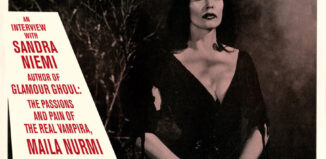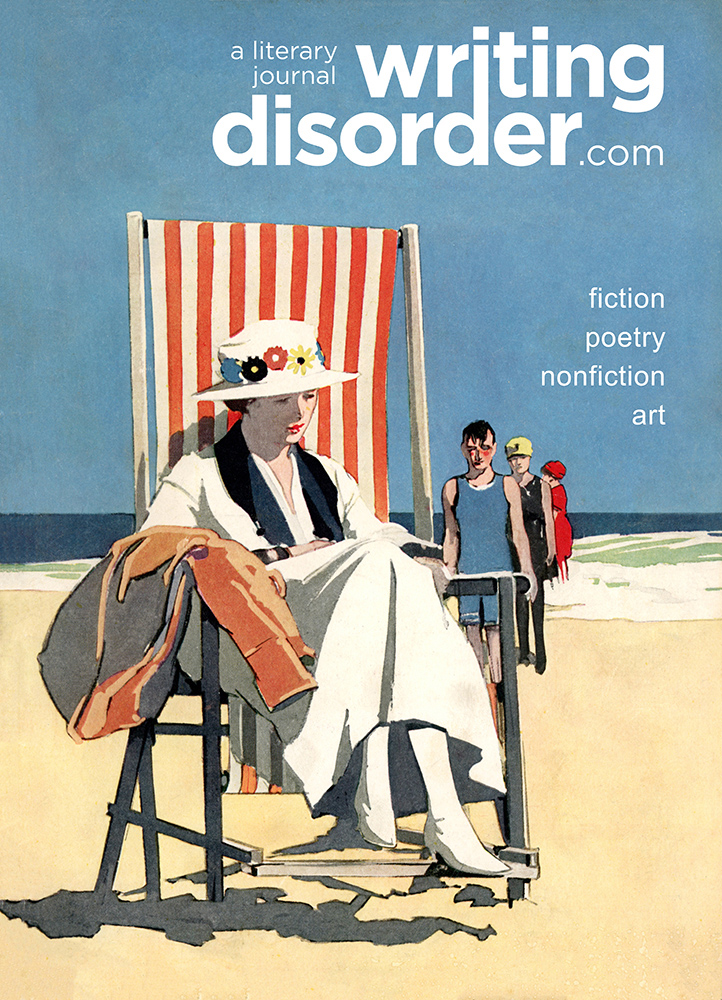José María Writes A Story
by Annette Freeman
“You know very well you’re not real.” —Lewis Carroll
A man met another man going towards the faculty office. It was last Wednesday evening, and I overheard their conversation. I was waiting for a bus. The two men stopped to speak, and I heard one ask the other if he knew the story of the English Department colloquium that had taken place some years ago, the one which prompted the decision to remove Experimental Fiction from the curriculum. The second man said he had not been there himself, but he had heard the story from someone who had been present. I happened to have some information about this famous (or infamous) incident, and I turned towards the two men. I introduced myself and apologised for interrupting them. After explaining the reasons for my interest in their conversation, and also intimating that I had some details about the incident in question, I abandoned the bus stop and we all retired to the faculty common room. We settled down to listen to the story that the second man had heard from someone who had been there.
“This was six or eight years ago,” he began. I interrupted briefly to suggest that it could have been as many as ten. He nodded in assent, and continued. “A group of English post-grads had gathered over an evening wine in the campus courtyard café. There were six or eight in the group and the topic under discussion was The Story. I mean, of course” (he said) “the concept of narrative as a vehicle for revealing life, truths — or lies. Each of the students present had a different view. One argued deeply for the merits of Moretti’s views on distant reading and the irrelevance of the canon. Another was passionate about Barthes’ views on the pleasures of the text. Yet another was a fanatic about Borges and talked for half an hour about labyrinths. Each had a particular spin on how fiction worked, and what the limits were (or even if there were any) on what a writer could achieve. After four or five of the students had given their views, each subtly different but equally earnest, there was a pause as a waitress hurried towards them bringing the pizza they’d ordered.”
It was at this point that I was able to interrupt again with the information that I had been that waitress. My companions were surprised and interested. I explained that I had been an undergraduate at the time, working a part-time job, and I’d managed to overhear only mere snatches of the now-legendary discussion, but I’d heard enough to make me wonder ever since just precisely what was said. I was intensely excited to have the chance to finally find out. Our companion continued.
“An older member of the group, a man with studious glasses and a striped scarf, returned from the bar with another bottle of house white (legend has it that it was chardonnay) and began refilling glasses. His companions reminded him that he had not yet given his views on the subject of The Story. His name was Dr. Joseph Martin and his specialty was Experimental Fiction, particularly that in the Hispanic tradition. Dr. Martin took a comfortable cross-legged posture on the couch and said that, indeed, he had a story for them. “Back in the ‘nineties,” he said, “I borrowed a copy of Lewis Carroll’s Alice Through The Looking Glass from a fellow I knew at school. He’d been given the book by a great-aunt, and he presented me with an anecdote to go along with it. I’ll tell you what he told me, and though I can’t vouch for the authenticity of it one way or the other, I’ve always thought that it had the ring of truth. You’ll have to decide for yourselves.” The students assumed expressions of alert interest. They approved of unreliable narrators, and prepared to engage with this story, whatever it was.
“Inside the front cover of the Lewis Carroll novel” (he went on) “given to my school friend by his great-aunt was a dedication, inked there in copper-plate handwriting: “To Mary Jo, from an admirer.” The great-aunt, whose name turned out to be Maria, told her great-nephew that she’d bought the book at a second-hand bookshop, long since closed, and that she’d found inside it, not only the inscription, but also a set of thin-folded pages.”
At this point, the students in the group couldn’t help some light-hearted jeering. The story was already difficult to believe, and it had barely begun. But their companion assured them that he was getting to the point, and that it was a point worth considering. He continued:
“My school friend and I discussed at some length how these pages might have found their way into the novel, and who their author might be. I wondered about the proprietor of the second-hand bookshop (who had been a notorious eccentric), but my school friend suspected his Great-Aunt Maria, a busty spinster who favoured pink crimplene outfits and who was known in their family for her pretensions to be a writer of fantastical allegories. When you hear the story told by those pages, you may understand why we were so interested in knowing their authorship.”
“Joe Martin was certainly a raconteur,” said the man who was telling us this story. “He knew how to craft the build-up, the hook, the tension, the telling details.” Certainly, I have never forgotten that pink crimplene outfit (though I had to Google ‘crimplene’). We had found a bottle of chardonnay in the common room fridge, overlooked from the last faculty drinks, and had settled down to listen, unconsciously mirroring the students in the story. The man who knew from someone who had been there, went on:
“ “This is the tale that was in that hand-written manuscript,” said Joe Martin. “My school friend had read the pages through as soon as his great-aunt had given them to him. He’d read them lying on his stomach on the floor of his bet-sit, on the floral carpet with the smell of dust in his nostrils. The hand-writing was, he told me (for I never saw the sheets myself) clear and legible, in blue ink; and the prose was literate and straight forward, leaving no ambiguities as to its meaning. It told a well-made story which followed a classic arc.”
The students protested: would he never get to the plot-line? Half the bottle of chardonnay was already gone, and they needed more pizza. At last he began…
“There was once…” What could be more classic than that opening? It lacked only the dark and stormy night, as I remarked to my companions in the faculty common room. “There was once a thin bearded man, a lawyer, who ran his own practice from an office in the city. Which city was not specified, but from the details which followed, I assumed it to be” (said Dr. Martin) “a modern western city in the 1970s or 1980s. The area of law in which he practised focused principally on commercial disputes. His days were filled with leases, contracts, commercial property, intellectual property, dictation to his secretary, and the reading of letters from his clients transferring their problems to him. In short, it was not a life that our hero found particularly congenial.”
I interrupted again at this point, as I wanted to know whether the story-teller’s use of “hero” indicated that we were going to hear a conventional Joseph Campbell arc; but our friend said no, Joseph Martin had merely adopted that term in re-telling the story to indicate the principal male protagonist, whose name was not yet revealed but which would be, momentarily. I nodded, and urged him to go on.
“Our hero was a great book lover. In his small apartment, where he lived alone, he had many books stored lovingly on bookshelves built for the purpose. There was little else in the apartment, as our hero was not someone who valued what he derisively called ‘things.’ In fact, apart from a large sofa which was also his bed, and a cupboard for his clothes, and of course a bathroom, the apartment held little other than the impressive array of books.
Many of these books had not yet been read by our hero, but his view was that a library of unread books was much more valuable than a library of books already read. Amongst his titles were the Karma Sutra, The Tibetan Book of the Dead, and Lewis Carroll’s Alice Through The Looking Glass. As soon as he had time he planned to read The Tibetan Book of the Dead, as he thought from its title that it would be a book after his own black heart. As to the Karma Sutra, he had purchased this in his youth when he had been under the spell of eroticism, but of late his interest in this subject had been waning. While he continues to admire pretty women, and is not immune to the pleasure of contemplating an impressive cleavage across a dinner table, these days he finds himself bored by the messy and brief business of sex. Alice Through The Looking Glass had been given to him by an aunt.
There was no kitchen in the ascetic apartment. Our hero ate all of his meals at a small bar downstairs where the waiters knew him, as he was such a frequent customer. He had his preferred seat on a stool at the window bench where he could read the daily newspaper, drink two or three espressos, and work himself up into a rage against the politicians of the day. After he’d been frequenting the bar for several months the waiters began to address him as ‘José María,’ which was not his name. He assumed that either they had mistaken him for someone else, or they had christened him with this Spanish name because of his dark beard and his habit of swearing colourfully under his breath while reading about politics (both well-known Latino traits.) He never corrected the waiters; he smiled to himself behind his beard when they called him José María. He liked the idea of having a nom de guerre, his real name unknown. He was a solipsist at heart, he thought.
One day, fed up with his daily work at the office, our hero decided that he would write a story. All his reading had convinced him that he too could write like those published authors” (the listening chardonnay drinkers smiled wryly in appreciation of this sentiment) “and in any case, his story would not be published. He would write for his own satisfaction.” (Chardonnay glasses were raised in salute.) “So in the afternoon he moved the hated commercial files from his desk, told his secretary that he was not to be disturbed, closed his office door firmly, and sat at his desk to write. He felt that he had some important and interesting things to say. For some time past he had been thinking, while driving to work, about a short story that he wanted to tell.
The story has as its heroine a woman, quite attractive, short, dark-haired, a nose like a strawberry and prone to smile a lot. José Marìa calls this character ‘Mary Jo’. He is pleased with this sobriquet, alluding as it does to his own pseudonym. This story, his first, describes Mary Jo as a rather eccentric person who lives alone, enjoys the company of handsome men, likes to read and to drink wine, and is a loyal friend. In the story, Mary Jo is taken out to dinner by a handsome bearded man, and the couple orders a good Rioja with their meal. It turns out that the bearded man” (who seems rather similar to someone we know, said Joe Martin) “is an incorrigible gossip. He asks Mary Jo a lot of questions about mutual friends of theirs, and about her love life. Since she is rather drunk, she happily gossips along with him. As the meal is finishing they are still chatting together amicably and maliciously. Mary Jo asks if the restaurant would serve her a glass of champagne. Champagne is one of Mary Jo’s weaknesses. The bearded man gallantly orders a whole bottle of Moet et Chandon and the two proceed to enjoy it together.
At this point in the conversation the bearded man asks Mary Jo to tell him an interesting story about her past love life. Mary Jo, it turns out, is a woman of little discretion who cannot hold her drink, and consequently she tells the bearded man about an affair she had in the past. This affair involved a love triangle and made a particularly interesting story, and the bearded man was well repaid for the champagne he had bought. The high point of Mary Jo’s anecdote came when she let slip a crucial detail about the man with whom she’d had the affair, whereupon the bearded man exclaimed: “I know him!” And indeed he did; and Mary Jo was mortified, even through the champagne haze.
Our hero, the putative José Marìa, was pleased with his first attempt at writing a story. He felt that his little tale illustrated the perfidy of the female and the reasons why sex is nothing but trouble. He drove home satisfied, and enjoyed dinner and a glass of red wine in the bar where they called him José Marìa, smiling behind his beard.
The next day he was sitting at his desk in the afternoon, dealing with the many terrible letters from his clients who wanted him to do many things immediately, and he was feeling put-upon and tired of it all. Perhaps, he thought, I will leave all this behind and become a full-time writer of clever and revealing stories. His secretary came to his door to announce that he had a visitor. A woman had arrived without an appointment and according to the secretary she was anxious to speak with him as soon as possible. Our hero put aside his daily mail and politely welcomed his new client into his office. The secretary closed the door as she went out and the visitor sat in the comfortable visitor’s chair in front of the desk. She was a short woman with dark hair, a distinctive strawberry-shaped nose, and a worried look. Our hero did not find her unattractive but he had sworn off all that sort of thing lately; he repressed any erotic thoughts. As he looked at his visitor she seemed strangely familiar, but he couldn’t place where he might have known her.
She soon came to the point of her visit. She blurted out her troubles, telling our hero that her name was Mary Jo, and that she had come to consult him, as a lawyer, about what she could do to stop a serious breach of confidential information. ‘José Marìa’ was dumbfounded. In a blinding light he recognised his visitor.
“But you cannot come to me for help!” he said. “You are my character and I am your author!”
At this Mary Jo burst into tears and the result was that José Marìa found himself in the peculiar situation of warmly embracing and comforting his own fictional character.”
By now the students drinking wine in the courtyard were laughing. I, waitressing at the time, was clearing glasses from nearby tables and I distinctly remember this moment, though I had no real idea of what had caused the outburst. I now learnt that the post-grads suspected Joe Martin of concocting this whole tale as a post-modern joke — the school friend, the manuscript in Alice Through The Looking Glass, the pink crimplene. Why couldn’t you tell us this funny tale without all that backstory, they asked? But he insisted that the story wasn’t his, that he had heard it from his friend who had found it in a book given to him by his great aunt Maria. And he went on: “it has another side, if you’ll stop scoffing for long enough to hear it.” The students urged him to explain himself, and he continued the story:
“Despite the fact that Mary Jo was a character whom José Marìa had invented in a short story, she felt real enough to him when he had his arms around her in a strong hug. Although he had recently decided that sex gave very little return on investment, this hug was pleasurable to both of them, and soon the author found himself in the possibly unique position of having an affair with a character from his own story.
But being the kind of man he was, José Marìa could not think about settling down domestically for more than an infinitesimal moment, and within a short time his affair with Mary Jo was over. She was rather upset about this, and for a while she would telephone and write him notes. But as he said to her, how could the relationship be expected to work, given that she was an invention of his?
Eventually Mary Jo accepted this philosophically and went back to the life he had created for her, living in her small apartment, reading books and drinking wine. At first José Marìa was curious as to whether Mary Jo could continue to have things happen to her, if he, her author, did not write more stories with plots and narratives describing her life. But curiously she seemed capable of carrying on alone, if in a rather monotonous round of doing the same things. But there was another concern. José Marìa was a kind, if eccentric, man and he didn’t like to think that Mary Jo, his Mary Jo, was sad or lonely. As she was his character he felt some responsibility for her. He decided to write another story in which her life improved.
In this new story Mary Jo was described as leading an inexorably happy life. She was given a wide group of friends, men and women, she went to parties, and enjoyed all the fun, sun and peace that her author could imagine. José Marìa couldn’t bring himself, however, to write a new lover for her. In this second story she always remained a little wistful and it was implied that she was carrying a torch for a certain handsome bearded man. Mary Jo came home to her apartment one afternoon after drinking wine in the sun with friends to find that a gift had been delivered. It was a small volume of Alice Through The Looking Glass. It was accompanied by an unsigned inscription which simply read: “from an admirer.” Mary Jo was thrilled to receive this gift and thought immediately that she knew who had sent it, though her author tried his best to stop her from leaping to conclusions. Similar small gifts continued to arrive intermittently over the next few weeks — nothing too ostentatious: a slightly worn copy of the Karma Sutra, or another small item that José Marìa didn’t want. He liked to see Mary Jo smile.
Despite that fact that he was a lawyer, José Marìa was also a skillful storyteller and he soon realised that his character Mary Jo was becoming flat and stereotypical, and to round out her character and make her more believable he needed to introduce some conflict into her life. So Mary Jo found the gift-giving puzzling, given her assumption about the identity of the gift-giver. She wondered if it indicated that José Marìa (her author) would like to renew their romantic relationship. Certainly she had been enjoying life recently, and she was smart enough to realise that she owed this substantially to José Marìa. She thought of him fondly and looked forward to the possibility of reviving their love affair. Unfortunately this possibility was scotched when, one evening on the promenade by the sea, she spotted José Marìa having an aperitif at a small beachside café (which had once been “their” favourite café) with a dark Spanish-looking beauty. It seemed that José Marìa had moved on in his love life.
Mary Jo, being only human, felt a twang of jealousy. Her author had included this trait in her character when he had first invented her. It was his belief that the tendency to jealousy is innate in all women (he was, at heart, a gentle misogynist), and so he felt that he could not leave this characteristic out of Mary Jo.
Mary Jo’s jealousy was well-founded. José Marìa had indeed gone back to his philandering ways. He took the Spanish-looking beauty on a short vacation to a tropical resort where they enjoyed a romantic weekend in a luxurious hotel. This was rather a large investment for José Marìa, but to ensure that he got value for money he took home with him the free souvenir sarong that the hotel had left covering the sumptuous bed. It featured palm trees and parrots and was vividly and tropically coloured, and had printed across it “Port Douglas” in large curlicue letters. José Marìa was happy with this souvenir, reminding him as it did of the enjoyable time he had spent on the hotel bed.
He returned home. Some weeks passed, as did the Spanish beauty, who moved on like all of José Marìa’s women. She had been a passing fancy. One day he was looking through his desk drawers for a misplaced document when he came across the half-finished story he had written about Mary Jo. He felt a little sentimental at the thought of her and decided to continue the story by sending her another little gift. After all, she was special amongst all the women he had known, in that he had invented her. So he wrapped up the souvenir sarong and left the small parcel on the doormat of her apartment on his way home from work. He had written on the package, in rudimentary Spanish (which he’d picked up from his last girlfriend): ‘para Mary Jo, un abrazo fuerte, J-M.’
When Mary Jo discovered the package and saw who it was from, she was rather annoyed. “Just another useless gift, sent to confuse me!” she said. She tossed it onto her coffee table with some junk mail and forgot about it for several days. Eventually she was curious enough to open it. Her character naturally had some stereotypical feminine curiosity, so she couldn’t resist forever. Mary Jo opened the package and shook out the sarong. She saw the words “Port Douglas” emblazoned across it and recognised it immediately as a souvenir sarong from a certain big hotel. It so happened that she was quite well aware of José Marìa’s trip to Port Douglas and with whom it had been taken. It had been the subject of extensive gossip in the chic waterside bars where their mutual friends drank cocktails, and of course, as we know, Mary Jo’s author had created her to be a gossip (that was where the trouble had started.) It did not take too much feminine intuition (with which Mary Jo’s author had generously endowed her) to imagine the sarong draped over the hotel bed and the goings-on which were accomplished on top of it.
José Marìa had included patience and intelligence in Mary Jo’s character, so she waited for a few days, thinking the matter over. Eventually she decided that José Marìa needed to know what an insulting gift he had given. She decided to write to him and explain the error he had made. As she composed this note in her mind a better idea came to her. She would write a short story in which retribution was delivered to José Marìa, gently but very clearly. She sat down at her kitchen table with a pen and paper.
Mary Jo took for the form of her story the contemporary fable. She favoured stories with a clear-cut moral message. After opening with a moving passage reprising their early relationship, and describing the shock of the gift in poor taste, she added a confrontation on the telephone. She called José Marìa and told him firmly that his gift was insulting. She included a little shouting (for verisimilitude — they were, after all, both strong-minded people). At first José Marìa could not understand what he had done wrong. However he eventually understood Mary Jo’s point when she threatened to send him an intimate item belonging to her new boyfriend (a person she invented for the purpose of the argument). José Marìa agreed that he would certainly not like to receive such a thing, even freshly laundered.
José Marìa was chastened, but he decided that it was best to move on and to forget all about Mary Jo, even though she was his creation. Mary Jo, for her part, certainly wanted to forget all about José Marìa. She went on with her life. One afternoon she was in her apartment stirring a risotto (her specialty — her author had made sure she was a good cook), and she was listening to the radio. The broadcast was a talk show which José Marìa often listened to when he was driving home. The radio host began taking phone calls from people who were encouraged to describe the worst gift they had ever been given. Mary Jo realised immediately that she had a winning story, so she phoned the radio show and broadcast — to the whole city — the story of José Marìa’s gift to his ex-girlfriend of the sarong upon which he had had his adventures with a new woman. The radio host was incredulous. People began calling in from all over the city, amused and amazed at the idiocy of José Marìa. As he listened in his car her author was appalled. She had named him to the world, but luckily ‘José Marìa’ was a nom de plume.
This story was Mary Jo’s revenge on José Marìa and she was satisfied with it. It suited her sense of justice, which her creator had made strong in her. The radio show was offering a prize for the best ‘bad gift’ story, and Mary Jo won it hands down. The next day a huge bunch of red roses and a beribboned basket full of chocolate was delivered to her door. But the day after she also received a letter from the radio station sending her two movie tickets as her prize. She wondered who had sent the flowers and chocolates. She had not written that ending to her story.”
As the man who knew from someone who had been there finished his report on Joe Martin’s tale, the chardonnay bottle stood empty and the faculty common room was still. We silently contemplated the devastating effect of allowing a fictional character free reign, of undermining authorial authority, and of generally letting meta-fiction get out of hand. We gulped a little and each turned pale, as the full import of such a nightmare scenario sank in. Unlike the mocking students of long ago, none of us doubted the truth of the tale. I rose, walked to the common room bookshelf and picked up a copy of Unamumo’s Neibla, a text which had, for a while after the incident, been more or less banned in the English Department. Now I knew why.
BIO
 Annette Freeman is a writer living in Sydney, Australia. She was born and raised in Tasmania, which she suspects is reflected in her writing in ways too mysterious to analyse. Her shorter work has appeared in the University of Sydney Student Anthology, BrainDrip Magazine, Collective Hub Magazine and Travel Post Monthly. She has a Masters of Creative Writing from the University of Sydney, the support of a terrific writing group, and boundless respect for a fine sentence.
Annette Freeman is a writer living in Sydney, Australia. She was born and raised in Tasmania, which she suspects is reflected in her writing in ways too mysterious to analyse. Her shorter work has appeared in the University of Sydney Student Anthology, BrainDrip Magazine, Collective Hub Magazine and Travel Post Monthly. She has a Masters of Creative Writing from the University of Sydney, the support of a terrific writing group, and boundless respect for a fine sentence.


















